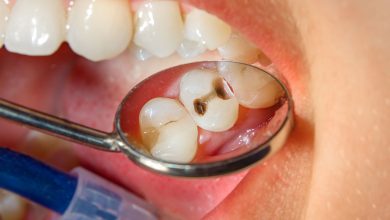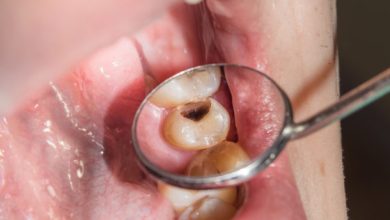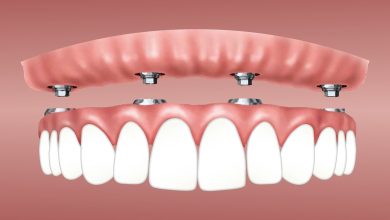Why Does Tooth Decay Happen? Discover the Shocking Truth

Tooth decay is caused by the acids produced by bacteria in the mouth that erode the enamel, leading to cavities. Tooth decay, a common dental problem, occurs when the protective layer of the teeth, known as the enamel, is gradually worn down by the acids produced by bacteria in the mouth.
This erosion leads to the formation of cavities, which can cause pain, sensitivity, and even tooth loss if left untreated. Although poor oral hygiene and a high-sugar diet contribute to tooth decay, it primarily occurs due to the activity of harmful bacteria.
Understanding why tooth decay happens is essential for maintaining good oral health and preventing dental complications in the future. We will delve into the causes, risk factors, and preventive measures for combating tooth decay, allowing you to take proactive steps towards preserving your dental well-being.

Credit: www.amazon.com
The Role Of Tooth Decay In Oral Health
The role of tooth decay in oral health is significant. Tooth decay, also known as dental caries or cavities, occurs when the hard outer layer of the tooth, called the enamel, is damaged by acids produced by bacteria in the mouth. This process can lead to various oral health issues if left untreated.
Understanding how tooth decay affects oral health is crucial for maintaining good dental hygiene. The decay compromises the structural integrity of the tooth, leading to pain, sensitivity, and difficulty in chewing. If not addressed, tooth decay can progress, causing the infection to spread to the surrounding tissues, including the gums and the roots of the tooth.
Moreover, tooth decay can also lead to bad breath, the formation of abscesses, and even tooth loss in severe cases. It is important to address tooth decay promptly through regular dental check-ups, proper oral hygiene practices, and a healthy diet low in sugary foods and beverages.
The Process Of Tooth Decay
Tooth decay occurs due to a complex process involving plaque formation, demineralization of enamel, bacterial invasion, and cavity formation. It all starts with the formation of plaque, which is a sticky film that develops on the teeth. This plaque harbors bacteria that feed on sugars and produce acids. Over time, these acids erode the enamel, leading to demineralization, which weakens and breaks down the protective layer of the teeth.
As the enamel breaks down, the bacteria can invade the tooth, leading to the formation of cavities. The bacteria continue to multiply and produce more acids, causing further damage to the tooth structure. If left untreated, the decay can progress to affect the inner layers of the tooth, including the dentin and pulp, leading to more serious dental problems.
Sugar: The Hidden Culprit Behind Tooth Decay
The link between sugar and tooth decay is well-documented. Frequent consumption of sugar has a significant impact on oral health and is a major contributor to the development of tooth decay. When sugar is consumed, it interacts with bacteria in the mouth, forming an acidic environment that erodes tooth enamel. Over time, this erosion weakens the teeth, leading to cavities and other dental issues.
It’s important to note that it’s not just the amount of sugar consumed that matters, but also the frequency. Constant exposure to sugar throughout the day, such as sipping on sugary drinks or snacking on sugary foods, prolongs the period of acidity in the mouth, increasing the risk of tooth decay.
Reducing sugar consumption can play a crucial role in maintaining good oral health. By cutting back on sugary snacks and beverages, practicing regular oral hygiene, and visiting the dentist for check-ups, individuals can prevent or minimize tooth decay and its detrimental effects.
Acidic Foods And Drinks: Silent Destroyers Of Teeth
The damaging effects of acidic foods and drinks on teeth cannot be underestimated. Acidic substances can erode the enamel on our teeth, leading to tooth decay. When the enamel is worn down, it exposes the sensitive dentin underneath, making teeth more susceptible to decay. Consuming excessive amounts of acidic foods and drinks can cause a pH imbalance in the mouth, creating an acidic environment that promotes the growth of harmful bacteria. These bacteria produce acids that attack the teeth, causing cavities and tooth decay.
It is important to be aware of the acidic content in our diet. Common culprits include citrus fruits, tomatoes, sodas, sports drinks, and fruit juices. Eating or drinking acidic substances in moderation, and rinsing the mouth with water or brushing the teeth afterward, can help minimize the damaging effects of acid erosion. Additionally, using fluoride toothpaste and visiting the dentist regularly for check-ups and cleanings can help prevent tooth decay and maintain optimal oral health.
Poor Oral Hygiene: Enabling Tooth Decay
Tooth decay occurs when bacteria in the mouth produce acids that erode the enamel on our teeth, leading to cavities. One of the main contributors to tooth decay is poor oral hygiene. Regular brushing and flossing are essential for maintaining good oral health. Brushing twice a day and flossing once a day can remove plaque, which is a sticky film of bacteria that forms on teeth. Neglecting oral hygiene can quickly become a recipe for decay, as plaque builds up and turns into tartar. Tartar is harder to remove and provides a perfect environment for bacteria to thrive and produce more acids. Additionally, regular dental check-ups can help detect any early signs of decay, allowing for timely intervention. By prioritizing oral hygiene, we can significantly reduce the risk of tooth decay and enjoy a healthy smile.
Fluoride: Defender Against Tooth Decay
Tooth decay is a common dental problem that occurs when the natural bacteria in the mouth produce acids that erode the enamel and outer layer of the teeth. Fluoride is a crucial component in preventing tooth decay and maintaining optimal dental health.
Fluoride works by strengthening the tooth enamel, making it more resistant to the acid attacks caused by bacteria and sugary foods. This mineral helps remineralize the teeth, repairing any damage that has occurred. It also inhibits the growth of harmful bacteria in the mouth, reducing the risk of cavities.
Using fluoride toothpaste and mouthwash can significantly reduce the occurrence of tooth decay. Additionally, fluoridated water can provide a constant supply of fluoride to help protect teeth. Regular visits to the dentist for professional fluoride treatments can also be beneficial, especially for individuals at higher risk of decay, such as children and those with a history of dental problems.
| Benefits of Fluoride in Dental Care | Explanation |
|---|---|
| Strengthens tooth enamel | Fluoride strengthens the outer layer of the teeth, making them more resistant to acid attacks. |
| Promotes remineralization | Fluoride helps repair damaged tooth enamel by promoting the remineralization process. |
| Inhibits bacterial growth | Fluoride reduces the growth of harmful bacteria in the mouth, reducing the risk of cavities. |
Genetics And Tooth Decay: Unveiling The Influence
Genetics and Tooth Decay: Unveiling the Influence
The impact of genetics on susceptibility to tooth decay
Did you know that genetic factors play a significant role in cavity formation? Research has revealed a strong link between genetics and tooth decay, shedding light on why some individuals are more prone to dental caries than others. Through various studies, scientists have identified specific genes that are associated with an increased susceptibility to cavities.
One such gene is known as the “beta-defensin 1” gene, which plays a vital role in the immune system’s response to oral bacteria. If this gene is not functioning optimally, the protective barrier against bacterial invasion weakens, making individuals more susceptible to tooth decay. Additionally, studies have identified other genes that affect tooth enamel formation and saliva composition, further affecting cavity risk.
Understanding the genetic predisposition to tooth decay can help dental professionals devise targeted preventive strategies for susceptible individuals. Regular dental check-ups, proper oral hygiene practices, and a healthy diet can be even more crucial for those with a genetic predisposition to cavities.
The Role Of Dental Fillings In Tooth Decay Treatment
Tooth decay is a common dental problem that occurs when bacteria in the mouth produce acids that erode the tooth enamel. Factors such as poor oral hygiene, a high sugar diet, and genetics can contribute to the development of tooth decay. In order to treat tooth decay, dental fillings are often used to restore the proper function and structure of the affected tooth.
Dental fillings are materials that are used to fill the cavities caused by tooth decay. There are several types of dental fillings available, including amalgam fillings, composite fillings, ceramic fillings, and glass ionomer fillings. Each type of filling has its own advantages and disadvantages, and the choice of filling material depends on factors such as the location and severity of the decay, cost, and patient preference.
Amalgam fillings, also known as silver fillings, are made of a mixture of metals and have been used for many years. They are durable and less expensive compared to other types of fillings. Composite fillings are made of a tooth-colored resin material and are aesthetically pleasing. Ceramic fillings, also known as porcelain fillings, are durable and resistant to staining. Glass ionomer fillings are made of a mixture of glass and acrylic and release fluoride to help prevent further decay.
In conclusion, dental fillings play a crucial role in the treatment of tooth decay. The type of filling used depends on various factors, and it is important to consult with a dentist to determine the most appropriate filling material for individual cases. With proper dental care and regular check-ups, tooth decay can be treated effectively, restoring oral health and preventing further complications.
Prevention Is Key: Strategies To Keep Tooth Decay At Bay
Effective oral hygiene practices play a crucial role in preventing tooth decay. Brush your teeth gently but thoroughly at least twice a day using a fluoride toothpaste. Don’t forget to replace your toothbrush every three to four months or sooner if the bristles are frayed. Floss daily to remove plaque and food particles from between your teeth and along the gumline.
In addition to your oral hygiene routine, making smart dietary choices can also help prevent tooth decay. Limit your intake of sugary and acidic foods as these can contribute to enamel erosion and cavity formation. Instead, opt for calcium-rich foods like cheese and yogurt that can promote enamel remineralization. Drink plenty of water to help wash away food debris and maintain saliva flow, essential for protecting teeth.
| Do’s | Avoid |
|---|---|
|
|
Frequently Asked Questions On Why Does Tooth Decay Happen?
What Is The Main Cause Of Tooth Decay?
Poor oral hygiene is the main cause of tooth decay. Not brushing and flossing regularly allows plaque to build up on teeth, forming acids that erode the enamel. Bacteria in the plaque feed on sugars and starches from food, producing even more acid that leads to cavities.
What Are 5 Causes Of Tooth Decay?
Sugar, poor oral hygiene, acidic foods, dry mouth, and genetics are the five main causes of tooth decay.
How Do You Fix Tooth Decay?
To fix tooth decay, you need to visit a dentist. The dentist will first remove the decayed part of the tooth and then fill it with a dental filling, such as amalgam or composite resin. In severe cases, a dental crown may be necessary.
Regular dental check-ups and proper oral hygiene can help prevent tooth decay.
Do Tooth Decay Go Away?
Tooth decay doesn’t go away on its own. It requires treatment like fillings or dental procedures to remove the decayed parts and prevent further damage. It’s important to take care of it promptly to avoid more serious dental issues in the future.
Conclusion
Tooth decay is a common dental issue that occurs due to several factors such as poor oral hygiene, sugary foods, and bacteria. Understanding why tooth decay happens is crucial in preventing it. By maintaining good oral hygiene, cutting down on sugary foods, and visiting the dentist regularly, we can protect our teeth from decay.
Make sure to brush twice a day, floss regularly, and follow a healthy diet to keep your smile bright and cavity-free.




